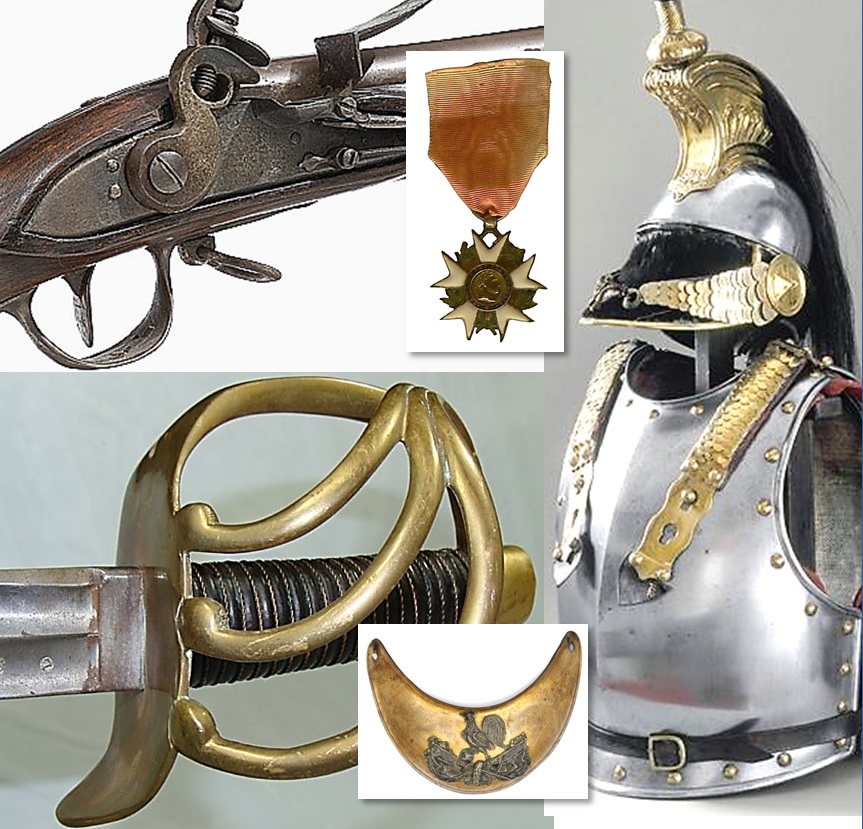
MANY MILITARIA collectors focus on a particular conflict or period simply because of aesthetics. Take for example WW2 German militaria. There is no doubt the engineering, design and manufacturing prowess of Germany as a nation was and still is unmatched and this is evident in the look and design of their military equipment. Antiques from this period have an aesthetic that appeal to many.
But one period for aesthetics stands out for militaria collectors, those collectors who regard themselves as connoisseurs. Few pieces of militaria combine fine art craftsmanship with historical significance as spectacularly as relics from the Napoleonic Wars.
The Napoleonic Wars (1803–1815) were a series of wars declared against Napoleon Bonapart’s French Empire by opposing coalitions including the British Empire. These wars were a continuation of the wars sparked by the French Revolution of 1789 during which masses on the streets, and peasants in the countryside overturned feudal, aristocratic and religious ruling. The Napoleonic wars revolutionised European armies, their technology and played out on a massive scale, mainly owing to the application of modern mass conscription.
Most of you would be forgiven for believing that militaria and relics from the Napoleonic era are so historically significant and rare that they can only be found in museums, or so expensive that only the most cash rich collectors can afford to own them. The reality is quite different. For those who know, there are plenty of relics out there, many at an affordable prices. If you have a taste for history and prepared to explore a different collecting niche, you too could become an agent for the preservation of the Napoleonic War heritage.
Here are our top tips for what to militaria to collect from the Napoleonic War period:
1) Napoleonic French Cuirassier Trooper Swords
When it comes to Napoleonic military accoutrements, the cuirassier sword is one of the most sought after. A huge and powerful weapon extending some 46 inches from pommel to tip, quite rightly this sword is deserving of its place in any Napoleonic War collection. It was a finely made, well balanced and effective weapon which went on to form the basis of all French heavy cavalry swords throughout the 19th century and was copied by a number of other countries. To add to its appeal; one thing you can be sure about French swords from this period is that the sword will have undoubtedly seen action as practically every Trooper did. Expect to typically pay anywhere from £450 for a good example.
2) Cavalry Cuirass and Helmet Set
The dream of every Napoleonic War collector is to own a set of cavalry armour. The rare First Empire cuirasses were distinctly pot-bellied in shape, had rivets all the way around, typically 28 of them, and were narrower at the shoulders than at the waist when seen from the front. They were secured secured by scale-covered leather straps over the shoulders. The cuirasses of later periods were more heroically shaped, with wide shoulders and narrow waist, and typically had only five rivets with chains securing them. Typically from £2,000 upwards.
3) Napoleonic AN IX Musket Long Gun
Nicknamed the ‘five foot clarinet’, the standard AN IX French infantry firearm was a muzzle-loaded, smooth bore long gun, fired from the shoulder. A soldier armed with a musket had the designation musketman or musketeer. An adaptation of the 1777 Model Infantry Musket the AN IX model was the last in a long line of modifications to the 1728 model commonly referred to as the “Charleville”, after one of the arsenals that manufactured them. Some of the unique elements of this model are the finger ridges on the trigger guard, a brass frizzen with a straighten cover, and the cheek piece carved in the stock’s butt. Expect to pay in the region of £950 to £1500 for a fair example.
4) Napoleonic Legion of Honor Order
The Legion of Honour, or in full, the National Order of the Legion of Honour was an award established by Napoleon Bonaparte in 1802. The Order is still today the highest decoration in France and is divided into five degrees: Chevalier, Officier, Commandeur, Grand Officier, and Grand Croix. First Empire crosses are generally divided into four successive types: 1) with no crown, 2) with a fixed crown 3) with a swivel crown, and 4) with a swivel crown and balls on the points of the cross. Prices for First Empire Legions of Honour vary with the grade and metal content. Expect to pay in the region of £600-£1,000 for the most common – a fourth model Chevalier cross.
5) Napoleonic Uniforms and Insignia
Unsurprisingly uniforms are almost impossible to find in great condition due to their deterioration over time, although they do turn up at auction and usually for a premium. Uniform accessories such as epaulettes and metal insignia such as shako and cartridge box plates, buttons, gorgets, and belt plates are far easier to locate with lower prices and therefore are our pick for you. Officers Gorgets were gilt crescents worn at the throat as a badge of rank and were worn until the fall of the Second Empire in 1870. Second Empire gorgets are often advertised as First, but if one pays attention to differences in the detailing of the eagles forming the crest of the Gorget, the chances of being taken are greatly reduced. Expect to pay £250 upwards for a fair example.

